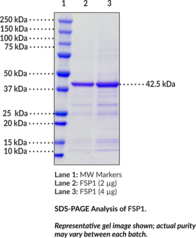Territorial Availability: Available through Bertin Technologies only in France
- Correlated keywords
- FSP 1 AIFM 2 GPX 4 Q 10 Co Q10 RSL 3 ML210 ML162 H 460 AMID PRG 3 p 53
- Product Overview:
Ferroptosis suppressor protein 1 (FSP1), also known as apoptosis-inducing factor mitochondria-associated 2 (AIFM2), is a flavoprotein and NAD(P)H-dependent oxidoreductase that inhibits ferroptosis in a glutathione peroxidase 4- and glutathione-independent manner.{50700,50699,45864} It is encoded by AIFM2 in humans and is composed of a short N-terminal hydrophobic region followed by a flavin adenine dinucleotide-dependent oxidoreductase domain.{50699} FSP1 localizes to the plasma membrane in a myristoylation-dependent manner, where it reduces coenzyme Q10 (CoQ10; Item No. 11506) to CoQ10H2. Reduced CoQ10 functions as a radical-trapping antioxidant and inhibits lipid peroxidation. AIFM2 expression positively correlates with resistance to glutathione peroxidase 4 (GPX4) inhibitors, including (1S,3R)-RSL3 (Item No. 19288), ML-210 (Item No. 23282), and ML-162 (Item No. 20455) in cancer cell lines. Withdrawal of the ferroptosis inhibitor ferrostatin-1 (Item No. 17729) reduces tumor growth in an Fsp1/Gpx4 double knockout, but not a Gpx4 single knockout, H460 lung cancer mouse xenograft model, indicating that FSP1 confers resistance to ferroptotic cell death. Cayman’s FSP1 (human, recombinant) protein can be used for enzyme assay applications.
Cayman Chemical’s mission is to help make research possible by supplying scientists worldwide with the basic research tools necessary for advancing human and animal health. Our utmost commitment to healthcare researchers is to offer the highest quality products with an affordable pricing policy.
Our scientists are experts in the synthesis, purification, and characterization of biochemicals ranging from small drug-like heterocycles to complex biolipids, fatty acids, and many others. We are also highly skilled in all aspects of assay and antibody development, protein expression, crystallization, and structure determination.
Over the past thirty years, Cayman developed a deep knowledge base in lipid biochemistry, including research involving the arachidonic acid cascade, inositol phosphates, and cannabinoids. This knowledge enabled the production of reagents of exceptional quality for cancer, oxidative injury, epigenetics, neuroscience, inflammation, metabolism, and many additional lines of research.
Our organic and analytical chemists specialize in the rapid development of manufacturing processes and analytical methods to carry out clinical and commercial GMP-API production. Pre-clinical drug discovery efforts are currently underway in the areas of bone restoration and repair, muscular dystrophy, oncology, and inflammation. A separate group of Ph.D.-level scientists are dedicated to offering Hit-to-Lead Discovery and Profiling Services for epigenetic targets. Our knowledgeable chemists can be contracted to perform complete sample analysis for analytes measured by the majority of our assays. We also offer a wide range of analytical services using LC-MS/MS, HPLC, GC, and many other techniques.
Accreditations
ISO/IEC 17025:2005
ISO Guide 34:2009
Cayman is a leader in the field of emerging drugs of abuse, providing high-purity Schedule I-V Controlled Substances to federally-licensed laboratories and qualified academic research institutions for forensic analyses. We are certified by ACLASS Accreditation Services with dual accreditation to ISO/IEC 17025:2005 and ISO Guide 34:2009.





